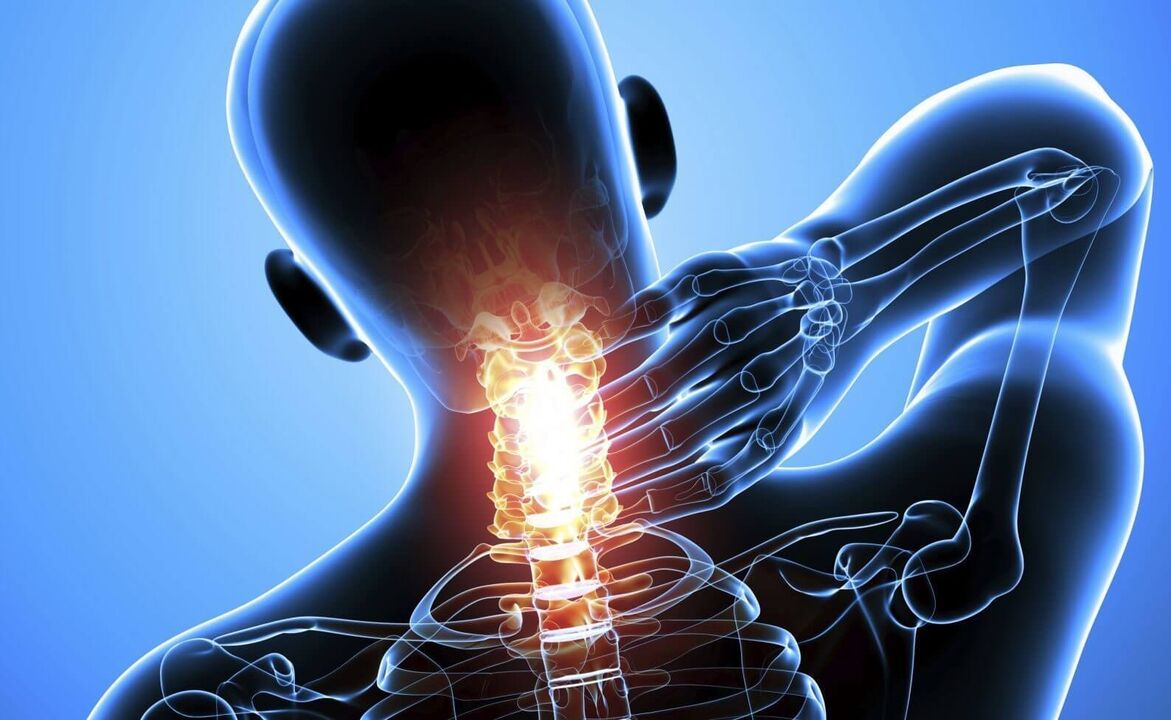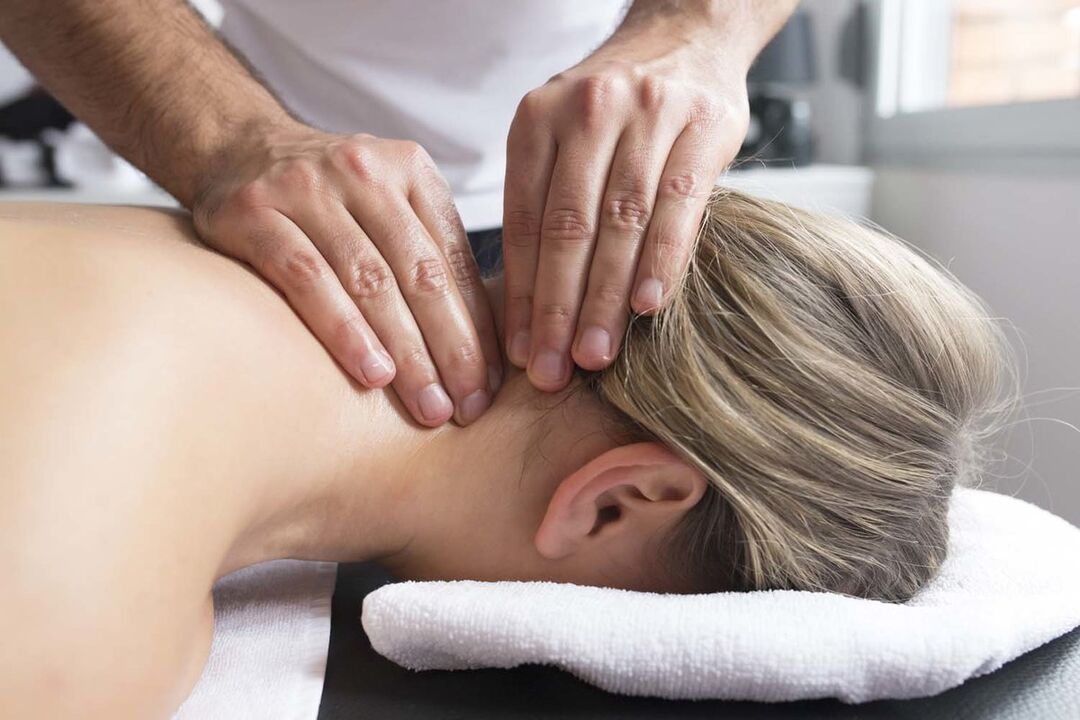
Many people suffer from osteochondrosis of the cervical spine.This disease progresses and develops gradually and imperceptibly, but at one not-so-beautiful moment it manifests itself as a worsening of general well-being and headaches.Is it possible to cure cervical osteochondrosis at home using folk remedies and which specialist should I turn to for help?
How does osteochondrosis appear and manifest?
The human cervical spine consists of seven vertebrae.They are connected by discs called intervertebral discs, with the nucleus pulposus located in the center.The creation of an irrational load on the spine, constant holding in uncomfortable positions, poor circulation, frequent muscle spasms ultimately lead to degenerative changes in the intervertebral cartilage of the cervical spine.The result of these changes is the appearance of cracks in the disc cartilage, into which the nucleus pulposus moves under the load of the spine.This movement causes compression of nearby structures - the substance of the spinal cord and spinal nerve roots, and, consequently, pain.
Anyone who takes care of their health can detect the first signs of the development of osteochondrosis.Most often, osteochondrosis of the cervical spine causes pain in the shoulder girdle, nape and neck.In addition, osteochondrosis causes cerebral circulation disorders, headaches, dizziness, and even loss of consciousness.
Most often, this disease occurs in people who lead a sedentary lifestyle or have a sedentary job, in whom the position of the head and neck during the working day is limited to a monotonous range of motion.If a person does not receive timely qualified treatment and tries to independently overcome the disease at home, the situation worsens - the distance between the vertebrae narrows, bone growths appear, which leads to a permanent partial or complete loss of the ability to work.
If the above symptoms appear, you should seek medical help.A vertebrologist treats various pathologies of the spine;however, you can find a specialist of this profile only in large medical centers.In the regular clinic, patients with osteochondrosis are treated by a neurologist, and in his absence, a therapist.Only a doctor after an examination can prescribe treatment (medical, folk, combined), adjust it or cancel it.
Stages of cervical osteochondrosis and its diagnosis
The clinical course of osteochondrosis is characterized by three main stages of development, which differ in symptoms and extent of the disorder:
- Phase 1– there are already cracks in the ring of the intervertebral disc;under load, the core can move sideways.At this stage, symptoms such as sharp shooting pains and spasms of the neck muscles, numbness of the tongue, dilated pupils, the appearance of Wright's syndrome (tingling and numbness of the hands when moving behind the head), Naffziger's syndrome (pinching of the lower roots of the brachial plexus and the subclavian muscle of the front joint;
- Phase 2- the distance between the vertebrae decreases, the fibrous ring dries up and as a result inflammation occurs due to capsule rupture.Also, the edges of the vertebral bodies are overgrown with osteophytes - specific bone growths.The symptoms of the first stage are accompanied by the so-called "falling head" syndrome, which forces the patient to support his head with his hands to reduce pain;
- Phase 3- in this phase, there is a complete rupture of the cartilage and prolapse of the nucleus pulposus and the formation of an intervertebral hernia.At this stage, symptoms such as periodic pain in the neck, headache and dizziness are observed, loss of consciousness is observed by sudden turning of the head, and limbs occasionally "stop listening".
To make a diagnosis, you should seek help from a neurologist, who will prescribe an in-depth examination after a preliminary examination.It includes radiography, magnetic resonance of the cervical and thoracic spine, angiography and ultrasound of blood vessels.The diagnosis of "osteochondrosis" is made only on the basis of X-rays and MRI data in the presence of changes in the structure of the vertebrae and discs.
How is the treatment carried out?

How to cure osteochondrosis of the cervical spine?Unfortunately, there is currently no treatment that can completely cure this disease.If the patient's condition is satisfactory and he does not need hospitalization, i.e. he can be treated at home, the doctor prescribes outpatient treatment, during which the patient visits the doctor and performs the procedures on the given days.In severe cases of the disease, a decision can be made on hospitalization.
Treatment of osteochondrosis of the cervical spine with drugs prescribed by a doctor usually includes orally taken drugs of the following groups:
- pain pills.Take for a long period of 1-2 weeks 3 times a day after meals;
- folk sedatives - lemon balm, valerian, St. John's wort.They are mild sedatives and prevent exhaustion of the nervous system due to the long-term presence of pain.It is accepted for 1-3 weeks;
- diuretics.They help reduce swelling in the area of inflammation;
- B vitamins - normalize muscle conductivity, help improve metabolic processes in nervous tissue;
- muscle relaxants - help to relax spasmodic muscles.
- chondroprotectors – drugs that help improve the structure of cartilage tissue and the performance of intervertebral discs.
In addition, gels, ointments, creams and various medicinal or folk rubs are used locally, which have an analgesic, warming and distracting effect.
Other treatments

In addition to medicines and folk remedies intended to alleviate the patient's condition, positional treatment is also prescribed.In the phase of exacerbation of osteochondrosis with pronounced pain, strict bed rest is prescribed, in which the physiological position of the body allows the load to be removed from the spine and pain reduction.Positioning treatment is prescribed for 1-3 days.Also, in the acute phase of osteochondrosis, doctors and physical therapy specialists recommend performing special breathing exercises and exercises at home that relieve muscle spasms.
In the subacute phase of cervical osteochondrosis, you can independently perform head turns and smooth bends at home.When muscle spasms occur, massage is a very effective way to relieve pain.You can do it yourself or trust the hands of experts.To prevent this disease, it is useful to undergo massage sessions twice a year.Therefore, the following means and methods are used to treat osteochondrosis of the cervical spine:
- gymnastics;
- massage;
- hirudotherapy (treatment with medicinal leeches);
- wearing a special neck brace;
- vertical traction of the cervix using a special device.
Diet and maintaining a healthy lifestyle play an important role in the treatment of this disease.Drinks and food products that contribute to anxiety and spasm of the spine muscles should be excluded from the diet.Forbidden drinks and food are: tea and coffee, alcohol and hot spices, marinades and smoked food.Fresh vegetables and fruits, grains and legumes, nuts and boiled eggs, dairy and fermented milk products and lean fish, beef and poultry will be beneficial for cartilage and joint tissue.






















